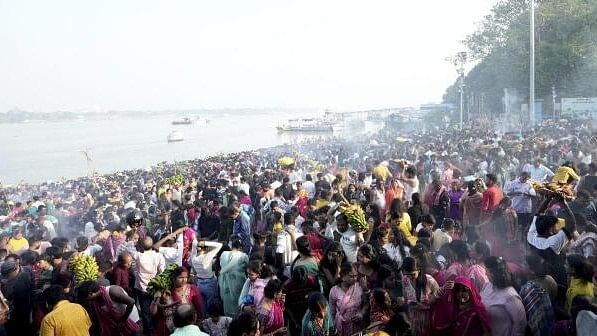
Devotees gather at the bank of River Ganga to offer prayers to Sun God on the last day of Chhath Puja festival, in Kolkata, Friday, Nov 8, 2024.
Credit: PTI Photo
Kolkata: People in large numbers offered morning prayers to the rising sun on the last day of Chhath Puja here and across West Bengal on Friday.
Thousands of devotees — mostly from Bihar and Jharkhand — headed toward the ghats set up by the Kolkata Municipal Corporation and Kolkata Metropolitan Development Authority (KMDA) in 80 waterbodies across the city and 28 along the Ganga.
Chhath is observed on the sixth day of Kartik Shukla and six days after Diwali. During the festival, worshippers pray to 'Chhathi Maiya' and the Sun God and seek blessings for their families and children.
Meanwhile, an official from the West Bengal Pollution Control Board said while noise pollution level was significantly better than in previous years, "the air quality index on average rose from 110 PM 2.5 to 135 in the morning, which is classified as 'moderate.'"
He added, "We have found moderate levels of air pollution during Chhath Puja in the last two days—November 7 afternoon and November 8 morning. Noise pollution was well within the limit due to the use of green crackers." The official also mentioned that the AQI was expected to decrease later in the day, falling below 100.
The authorities had granted time from 6 am to 8 am for bursting of crackers during Chhath, which is considered an integral part of the festivities.
However, striking a different note, environmentalist Somendra Mohan Ghosh said, "If we consider the safe limit for Respirable Suspended Particulate Matter (PM2.5) as 140 mg per cubic meter, the levels observed after Chhath Puja were still concerning." He added, "The level was 3.5 times higher than the permissible limit as per Indian standards, and if we consider the WHO's safe limit, it was nine times higher."
Ghosh also noted that fewer fireworks and crackers were used this year compared to previous celebrations, and the bursting mainly took place in specific areas like Bhawanipore, Chakraberia, parts of Ballygunge, Chetla, Cossipore, Beleghata, and Chitpur, among others.